|
In the middle of the desert on the peninsula of Baja California in Mexico, one finds the Mission of Saint Gertrudis La Magna, the meeting point between the indigenous cochimi culture and European civilization as represented by the Spanish missionaries. Officially founded in 1752 and located exactly in the middle of the peninsula, the Mission of Saint Gertrudis La Magna served as a link between the northern and southern missions. This paved the way for missionaries to carry their purpose all the way to Northern California, where they gave birth to many cities including the three most important ports of the state of California, in the United States.
The colonization of the peninsula and Northern California can only be understood by looking at the combined effort between the Spanish and the natives. They strove to establish themselves in a terribly inhospitable climate marked by arid land, scarcity of water, and the difficulties in communication and understanding between the two cultures. It was under these conditions that the missionaries arrived at a tiny fountain of water located slightly north of parallel 28, and where the indigenous architect Andres Comanaji began constructing the mission. With his own hands he built a chapel made of machimbre (a mixture of sticks and mud), several bedrooms, a kitchen/dining room, and a dispensary. A difficult and exhausting task for anyone and even more so for this architect who was blind.
The mission gave life to the region where they soon began cultivating vines, wheat, corn, fig, and dates. The colonizers and the indigenous cochimi were then able to join forces in developing the manufacture of wine and honey, in learning professions, making dresses, tanning hides, taking care of livestock, building roads, and learning to speak, read, and write the Spanish language. The years went by, and thanks to the will of the Marquis of Villalpuente to honor his wife Doña Gertrudis de la Peña, all of the structures made of machimbre and adobe were rebuilt by using quarry. These new structures were completed around 1796, and one of them has been used as a temple ever since. The original single-walled bell tower, (precursor to the belfry), is still standing 78 meters away from the buildings and is unique in the entire peninsula, having three bells from the period.
Having colonized the more hospitable valleys to the north and established sea trade to the south, the Mission of Saint Gertrudis, located in the rough central area, slowly began to decline until it was completely abandoned in 1822. Today the Mission of Saint Gertrudis La Magna is still a place of worship, surrounded by lush vegetation that it helped to plant more than 100 years ago, and still standing quietly in the middle of the desert as a timeless ornament symbolizing the human effort to civilize the route to California. The Mission of Saint Gertrudis La Magna, an example of the best of the latin spirit. |
|
|
 Can
a port be at a higher altitude than 3,800 meters above the sea level?
Can
a port be at a higher altitude than 3,800 meters above the sea level?